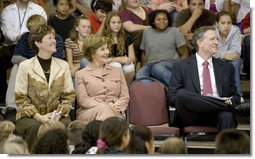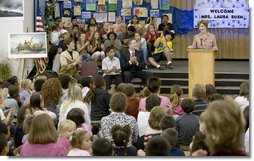|
Home >
News & Policies >
October 2008
|
For Immediate Release
Office of the First Lady
October 2, 2008
Mrs. Bush's Remarks at a Picturing America Event
Riverside Elementary School
Bismarck, North Dakota
2:57 P.M. CDT
MRS. BUSH: Thank you very much, Torrance. Thank you all. Thank you for the very warm welcome. Thank you, Torrance, for sharing your thoughts about Childe Hassam's painting. This painting over here -- see, the one with all the flags -- that's the one that Torrance was talking about. And it's a depiction -- it's a beautiful painting of Allies Days -- Allies Day in New York City. It was the end of World War I, and this is what the city looked like, with flags hanging on every building as the troops -- as they get the word that the United States -- that World War I is over, and the United States is out of that war.
 I want to thank each of you for your warm welcome to North Dakota. This is
my very first visit to your state since President Bush took office. With
today's visit, I now have traveled to all 50 states during my time in the
White House. (Applause.) And clearly, I was saving the best for last.
(Laughter and applause.)
I want to thank each of you for your warm welcome to North Dakota. This is
my very first visit to your state since President Bush took office. With
today's visit, I now have traveled to all 50 states during my time in the
White House. (Applause.) And clearly, I was saving the best for last.
(Laughter and applause.)
I want to thank Dr. Lindsay for joining me here from the National Endowment for the Humanities. I want to recognize Mikey Hoeven, your Governor's wife, the First Lady of North Dakota. Thank you very much, Mikey, for joining me, as well. (Applause.)
I also want to recognize the state and local elected officials who've joined us. Thank you for coming. Thank you, Mr. Speaker, as well as the state reps that are here.
Nancy Schafer is here, as well. She's North Dakota's former First Lady -- Nancy Shafer, right there. (Applause.) Her husband, Ed Shafer, was your governor, and now he's the current Secretary of Agriculture. He's on the President's Cabinet in Washington. And I know that she, Nancy, and Secretary Shafer, want me to remind everyone that National School Lunch Week is coming up on October 13th. National School Lunch Week is overseen by the Department of Education -- I mean, Department of Agriculture, sorry -- and it gives us a chance to recognize the food service professionals, and the school officials, and the parents who work with the Agriculture Department's school lunch program. And I just wanted to tell all the kids that you can get a head start on the week by remembering to make healthy food choices and to thank the people who work in your school cafeteria. (Applause.)
And a special thanks to all of the school officials who welcome me here today. Your Superintendent of Schools, Bismarck Public Schools, Dr. Paul Johnson -- thank you very much, Dr. Johnson, for joining me. (Applause.) Members of the Bismarck School Board that have joined us, thank you all for serving your communities. Thank you very much. (Applause.)
 Ms. Nelson, your principal at Riverside, thank you very much for welcoming
me, too. (Applause.) And a special thanks to the students at Riverside.
Thank you for letting me visit your school. (Applause.)
Ms. Nelson, your principal at Riverside, thank you very much for welcoming
me, too. (Applause.) And a special thanks to the students at Riverside.
Thank you for letting me visit your school. (Applause.)
Nearly 200 years ago, an adventurous Philadelphia lawyer sold off all his belongings and used the money that he got from selling off his belongings to buy a set of paintbrushes and paint. He taught himself how to draw portraits, and he set off on a journey to a land that he called the "Far West." Today, we call his destination North Dakota.
Over the next years, this self-trained painter, George Catlin, would meet 48 different tribes of American Indians, representing as many as 400,000 people. He would eventually paint hundreds of portraits of these hunters, warriors, farmers, and fathers. Today, fourth graders here at Riverside that I joined -- this group right over, Ms. Weekes' class -- we discussed his portrait of one man: Mah-to-toh-pa. And you see him in this far painting, the George Catlin painting. You can see the chief. It's very obvious who the chief in the painting is; he's the one who's dressed in the lighter, probably deerskin, and is wearing the headdress. This is a painting that George Catlin did, probably a little bit over -- less than 200 years ago here in your very state.
Catlin portrays the leader of the Mandan people in full dress, surrounded by those he's responsible for protecting. By painting this one scene of American daily life, the artist preserved the Mandan people's culture and history, dress and customs, for generations to come. And here we are, almost 200 years later, still looking at this painting by George Catlin, still wondering and wanting to know about the people that were in that painting, the members of the Mandan tribe.
George Catlin's artwork is now recognized as a cultural treasure. In fact, visitors to the White House can view a collection of Catlin paintings just outside the Cabinet Room. These portraits hang as a tribute to the role American Indians played in the United States history -- and the role they still play as participants in America's diverse culture.
Catlin's portrait of Mah-to-toh-pa is just one of 40 images that your school has been awarded through the National Endowment for the Humanities' Picturing America program. And Dr. Lindsay and Torrance already pointed out just a few of these iconic American images: Washington Crossing the Delaware; The Freedom March From Selma To Montgomery -- it's the photograph at the top of that painting. The George Catlin of the Mandan Indians; Childe Hassam's painting of New York City at the end of World War I. The others that are over here -- Norman Rockwell painting from a town hall meeting where they -- where Norman Rockwell paints the ordinary man who stands up to say what he thinks at a town hall meeting, to express his views; the freedom that he has to be able to do that. And then one of our classic landscapes that you can see in that beautiful painting.
 Each reproduction in the Picturing America collection depicts important
moments in American life, and they present these moments through paintings,
sculpture, photography, architecture, and the decorative arts. Together,
these images remind students that history is more than just a list of dates
and names; but it's an ongoing story that defines what it means to be a
citizen of the United States.
Each reproduction in the Picturing America collection depicts important
moments in American life, and they present these moments through paintings,
sculpture, photography, architecture, and the decorative arts. Together,
these images remind students that history is more than just a list of dates
and names; but it's an ongoing story that defines what it means to be a
citizen of the United States.
President Bush and I announced Picturing America at the White House in February. Since then, more than 20 percent of America's schools and libraries have been selected to receive this collection. This represents over 26,000 schools and libraries -- more than the number of awards the National Endowment for the Humanities has made in all of its grant programs in the past 20 years combined.
The National Endowment for the Humanities wants even more schools and libraries to benefit from this program. They've opened the application period for a second round of awards, which will be distributed in 2009. The deadline for these applications is at the end of this month. You might be interested to know that more than 75 North Dakota schools and libraries have been selected to receive this Picturing America collection, including 19 schools and libraries right here in Bismarck. We hope others join them and apply to receive this collection of our nation's iconic art.
George Catlin wrote that many people underestimated American Indian culture because they, he said, "didn't stop to investigate." Today, Picturing America is encouraging students across our country to stop and investigate these stories, people and ideals that define our culture. By teaching our youngest students about America's past, we can trust them to choose the best course for our nation's future.
Thank you all very much. And may God bless you. (Applause.)
END 3:08 P.M. CDT


